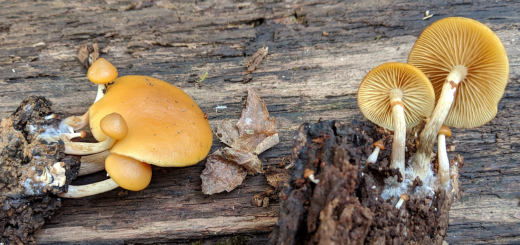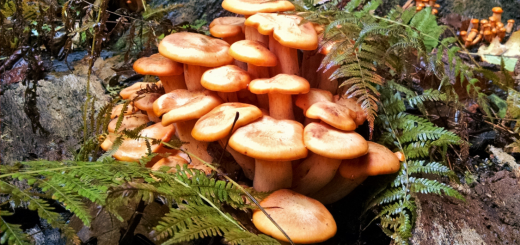#094: Muscarine
Muscarine is a toxin found primarily in small brown or white mushrooms in the genera Clitocybe and Inocybe. It is also found in other mushrooms, including the Fly Agaric, Amanita muscaria, but at much lower concentrations. Muscarine was initially isolated in the 1860’s by the German chemists Oswald Schmiedeberg and Richard Koppe, who were trying to research the psychoactive properties of the Fly Agaric. They isolated a compound – which they named muscarine after the Fly Agaric’s species name – that decreased heart rate in frogs and could even cause cardiac arrest when high concentrations were used.
Schmiedeberg and Koppe carried out a detailed analysis of the pharmacology of muscarine. They found that it slows heart rate, contracts smooth muscles (found in the stomach and intestines), makes breathing difficult, constricts the pupils, and increases production of mucus, saliva and tears. When they applied muscarine directly to the brain and spinal cord, they found it decreased muscle tone and dulled peripheral reflexes. Symptoms of poisoning by muscarine-containing mushrooms are very similar to the effects described by Schmiedeberg and Koppe. The symptoms appear rather quickly: within half an hour to two hours. They include PSL syndrome (Perspiration, Salivation, and Lacrimation – i.e. overproduction of sweat, saliva, and tears, respectively), diarrhea, muscle spasms, pupil constriction, blurry vision, low blood pressure, and slow heart beat. In some cases, these symptoms can result in death, but this usually only occurs if there was a preexisting heart problem.
Muscarine causes these diverse symptoms by activating muscarinic acetylcholine receptors. Muscarinic receptors are located in the parasympathetic nervous system’s links to the heart, exocrine glands, and smooth muscles. The parasympathetic nervous system is activated when the body is at rest or while eating, which explains the decrease in heart beat, decreased blood pressure, salivation, tears, and smooth muscle activity (including pupil constriction). Muscarinic receptors can also be found in the sympathetic nervous system’s links to the sweat glands as well as in the central nervous system, thus accounting for the remaining symptoms. These receptors are usually activated by the neurotransmitter acetylcholine. Muscarine is an “agonist” for acetylcholine, which means it also binds to muscarinic receptors, thereby activating those neurons inappropriately.
As a result of this mechanism of action, treatment of muscarine poisoning is a simple matter of turning off the parasympathetic nervous system. This is commonly done using atropine, which is a “competitive antagonist” for muscarinic acetylcholine receptors. In other words, atropine binds tightly to muscarinic receptors but does not activate them. This prevents other excitatory compounds (like acetylcholine or muscarine) from binding to the muscarinic receptors. Consequently, the neurons are not activated and the parasympathetic nervous system is turned off. Atropine is a common drug that is used to treat a variety of conditions, particularly those that are heart-related.
Muscarine is a small molecule with only 32 atoms. Its IUPAC (International Union of Pure and Applied Chemistry) name is: [(2S,4R,5S)-4-hydroxy-5-methyloxolan-2-yl]methyl-trimethylazanium. If you were a chemist, you could draw the structure of muscarine based on that name alone. I’m betting that most of you are not chemists, so you can look up the structure or read the following description. Muscarine is based on a five-atom ring consisting of four carbons and one oxygen. The last carbon in the ring is bound to a methyl group (CH3) and a hydrogen atom, the third is bound to a hydroxyl group (OH) and a hydrogen atom, the second is bound to two hydrogen atoms, and the first one is bound to a hydrogen atom and another carbon atom. This carbon atom is bound to a hydrogen atom and a positively-charged nitrogen atom (azanium, in the IUPAC name). Finally, the nitrogen atom is bound to three methyl groups.
Muscarine has been a useful compound for neurobiologists. It was the first parasympathomimetic drug (a drug which mimics the action of the parasympathetic nervous system) discovered, and as such has had a profound impact on our understanding of the parasympathetic nervous system in general and of muscarinic acetylcholine receptors in particular. In addition to its use in the study of neurobiology, muscarine and similar drugs are used when doctors need to increase muscle tone in the stomach, intestines, and/or iris. These drugs can also be used to slow a patient’s heart beat.
See Further:
http://www.botany.hawaii.edu/faculty/wong/BOT135/Lect18.htm (see Group V)
http://link.springer.com/chapter/10.1007%2F978-1-4612-4498-1_1
http://pubchem.ncbi.nlm.nih.gov/compound/muscarine
http://www.atsdr.cdc.gov/csem/csem.asp?csem=11&po=9
http://pubchem.ncbi.nlm.nih.gov/compound/atropine
For more on acetylcholine receptors:
https://www.ebi.ac.uk/interpro/potm/2005_11/Page2.htm
http://www.guidetopharmacology.org/GRAC/FamilyIntroductionForward?familyId=2









![#011: Characteristics of Kingdom Fungi [Archived]](https://www.fungusfactfriday.com/wp-content/themes/hueman/assets/front/img/thumb-small-empty.png)

1 Response
[…] attractive and smells pleasant, do not eat it! The Jack-O-Lantern contains the toxin muscarine (see FFF#094) and causes a variety of unpleasant symptoms. Most people will experience severe abdominal cramps, […]